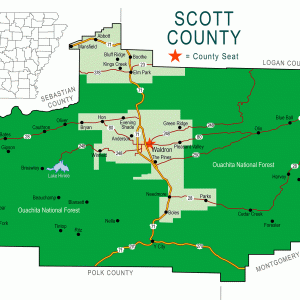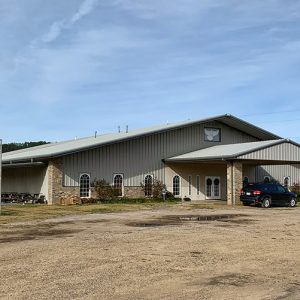calsfoundation@cals.org
Chant (Scott County)
Chant is a historical community in southern Scott County located along Highway 71. At various times known as Pleasant Valley and Texas, the town was established in 1906 near the Fourche La Fave River and Mill Creek between Boles and Y City. Agriculture has contributed significantly to the economy and way of life in Chant.
Prior to European exploration, the area surrounding Chant was a wilderness. Several species of wildlife that no longer inhabit the area, such as elk and buffalo, were present throughout the region. Numerous archaeological sites and burial mounds are located along the banks of prominent waterways such as the Poteau River. Archaeological findings have provided evidence of early inhabitants dating to the Archaic, Woodland, and Mississippian periods. Further archaeological evidence has indicated that the people of the Caddo tribe later inhabited the area.
During the late seventeenth and early eighteenth centuries, French hunters and tradesmen traveled west from the Arkansas Post, exploring portions of western Arkansas. These Frenchmen often traversed rivers and streams throughout the region. Several rivers that flow through Scott County were likely named by these explorers, including the Petit Jean, Poteau, and Fourche La Fave. It is probable that they traveled along the Fourche La Fave River near present-day Chant.
Settlers began arriving in the area now known as Chant during the late 1830s and early 1840s. In 1846, a post office called Texas was established in Chant halfway between the Chant Cemetery and where Highway 71 crosses the Fourche La Fave River. The first postmaster was Charles Hicks. The post office was discontinued in July 1860.
Men called to fight in the Civil War served with both the Confederacy and Union. The women and elderly were left to look after family homes and farms. Instances of bushwhacking occurred in the area during the war.
A large influx of people began moving to the area near Chant after the Civil War as a result of being displaced. The oldest marked grave in Chant Cemetery dates to 1870, though the cemetery was likely established earlier.
In May 1882, the Scott County Courthouse burned, destroying all records that defined the boundaries of the various school districts that had been established throughout the county. In August, the county court reestablished the boundaries of the fifty-six school districts active in the county, including Chant (Pleasant Valley) School District (Number 47). The Pleasant Valley schoolhouse was officially reestablished in October 1883. It was renamed Chant in 1906.
The Chant Post Office was established in 1906, with Robert Hall as the first postmaster. In 1923, the post office was discontinued and the mail sent to Boles. In 1929, the Chant School District was closed and consolidated with the Boles School District.
A sawmill was located in Chant until the 1930s. Mill Creek served a popular place for children to swim. Peddlers would come through Chant once a month selling material and staple foods.
In July 1963, the Hawthorne family opened Fred’s Restaurant in Chant. For years, the restaurant served as a popular eating establishment in Chant and the surrounding area.
Fred’s Restaurant was sold in 2011 and closed soon after. By 2019, the only surviving business in Chant was a gas station and quick mart located along Highway 71, next to the previous location of Fred’s (the gas station is also referred to as Fred’s Truck Stop). The Solid Rock Pentecostal Church of God serves as the community’s religious institution and voting center. Longview Baptist Church once existed in Chant but closed and became a residence.
In May 2013, a devastating flood struck Chant and the surrounding area, resulting in the deaths of five people: Sherriff Cody Carpenter, Wildlife Officer Joel Campora, Vivian Sue Reimer and Regina Kay Shearn of Y City, and Cathy Ann Holder of Dallas (Polk County). The flood damaged numerous buildings, houses, and agricultural properties in the area. It also altered portions of Mill Creek and the Fourche La Fave River, including the banks and the original trajectory of water flow.
Hunting and fishing are popular recreational activities in the area. Agriculture continues to be a prominent way of life in the community, mostly in the form of cattle and chicken farms.
For additional information:
Cate, Michael. History of Scott County, Arkansas. Dallas, TX: Curtis Media Corporation, 1991.
Echoes: The Scott County Historical and Genealogical Society Quarterly. Waldron, AR: Scott County Historical and Genealogical Society (1986–).
Goodner, Charles. Scott County in Retrospect. Mansfield, AR: Frank Boyd, 1976.
Goodner, Norman. A History of Scott County, Arkansas. Siloam Springs, AR: Bar D Press, 1941.
McCutcheon, Henry Grady. History of Scott County, Arkansas. Little Rock: H. G. Pugh and Company, 1922.
Ty Richardson
Richardson Preservation Consulting
 Scott County Map
Scott County Map  Solid Rock Church
Solid Rock Church 



Comments
No comments on this entry yet.